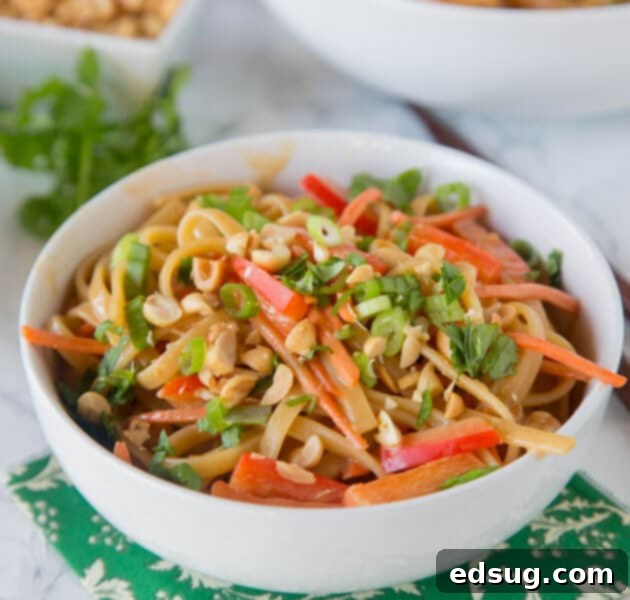Easy & Delicious Thai Peanut Noodles: Your Go-To Recipe for a Quick, Flavorful Meal
Indulge in these super easy Asian noodles, generously coated in a creamy, savory peanut butter sauce, and tossed with crisp bell peppers and tender carrots. It’s a delightful, satisfying dish that comes together in a flash!
There’s something irresistibly comforting about a warm bowl of Asian-style noodles, isn’t there? Lately, my kitchen has been filled with the aroma of these delicious dishes, and it seems many of you share this passion! Recipes like our popular Garlic Beef Noodle Bowls have become a staple, and I’m thrilled to introduce another fantastic option to your repertoire: these incredible Thai Peanut Noodles. They offer a delightful Thai-inspired twist that’s sure to become a new family favorite.
While this recipe is designed as a delicious meat-free dish, making it perfect for vegetarian meals or Meatless Mondays, don’t worry! I’ve included plenty of options for incorporating your favorite proteins and additional vegetables. This ensures the dish is not only incredibly filling but also a delicious and wholesome meal that everyone in the family will enjoy, tailored precisely to their tastes.
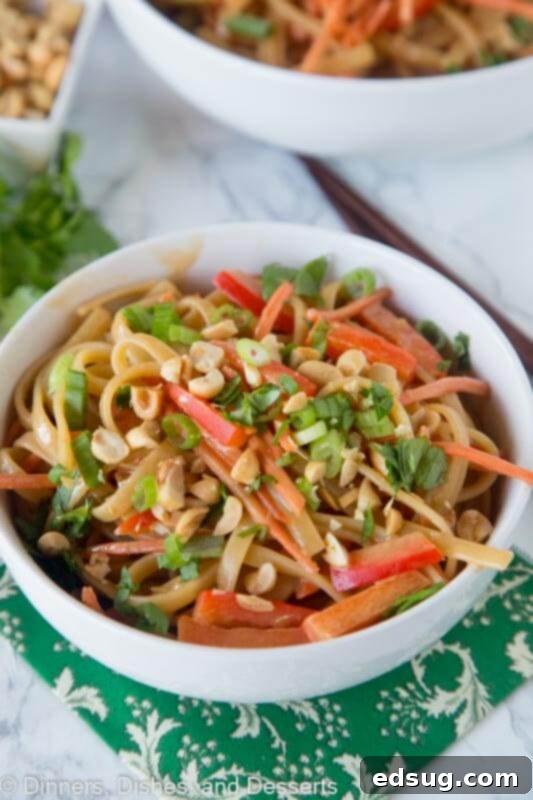
Why You’ll Adore This Thai Peanut Noodle Recipe
What makes these Thai Peanut Noodles so special? It’s the perfect blend of simplicity, speed, and incredible flavor. Here’s why this recipe will quickly become a go-to in your kitchen:
- Lightning Fast: From start to finish, this dish is ready in just 15 minutes, making it ideal for busy weeknights when you need a delicious meal on the table without fuss.
- Creamy & Flavorful: The homemade peanut sauce is truly the star. It’s rich, savory, slightly sweet, and boasts a hint of spice, coating every strand of noodle and vegetable beautifully.
- Highly Customizable: Whether you’re vegetarian, a meat-lover, or simply looking to clear out your fridge, this recipe is incredibly versatile. Add your favorite proteins, extra vegetables, or adjust the spice level to your liking.
- Family-Friendly: It’s a crowd-pleaser that can be easily adapted for picky eaters. Serve it mild for kids and offer chili flakes on the side for adults who crave more heat.
- Budget-Friendly: Made with common pantry staples and fresh vegetables, this dish is economical without sacrificing taste or nutrition.
- Great for Leftovers: These noodles taste fantastic the next day, whether enjoyed cold or reheated, making them perfect for meal prep.
Essential Ingredients for Your Thai Peanut Noodles
Gathering your ingredients is the first step to creating this delightful dish. Most of these items are likely already in your pantry or easily found at any grocery store. The beauty of this recipe lies in its simplicity and the ability to customize with what you have on hand.
- Noodles: The foundation of our dish! We’ll discuss the best choices below.
- Carrots: Shredded or matchstick carrots add a touch of sweetness, vibrant color, and a pleasant crunch.
- Bell Peppers: Any color works beautifully. Thinly sliced bell peppers contribute freshness and a mild, sweet flavor.
- Peanut Butter: The heart of the sauce. Creamy peanut butter creates a smooth, luscious texture, but crunchy can also add an interesting element.
- Water: To help achieve the perfect sauce consistency.
- Soy Sauce: For that essential umami depth and savory flavor. Low-sodium is always a good option.
- Honey: Balances the savory notes with natural sweetness. Maple syrup can be a vegan alternative.
- Rice Vinegar: Adds a crucial tang and brightness to the sauce, cutting through the richness of the peanut butter.
- Ginger: Freshly grated ginger provides a warm, zesty, and aromatic kick that defines Asian cuisine.
- Garlic: Finely minced fresh garlic is indispensable for a robust, savory base flavor.
- Sesame Oil: A finishing oil that adds a distinct nutty, toasty aroma and flavor.
- Crushed Red Pepper: For a gentle warmth and a subtle spicy kick. Adjust to your preferred heat level.
As you can see, this list combines pantry staples with fresh aromatics, ensuring a rich and balanced flavor profile. For the noodles, you truly have a lot of freedom! Just like with our Chow Mein Noodles with Chicken, the type of noodle is quite forgiving. While I often opt for ramen noodles (which, surprisingly, can spark quite a debate on Facebook!), the most important thing is to use your favorite noodle in ANY recipe to ensure you love the final outcome!
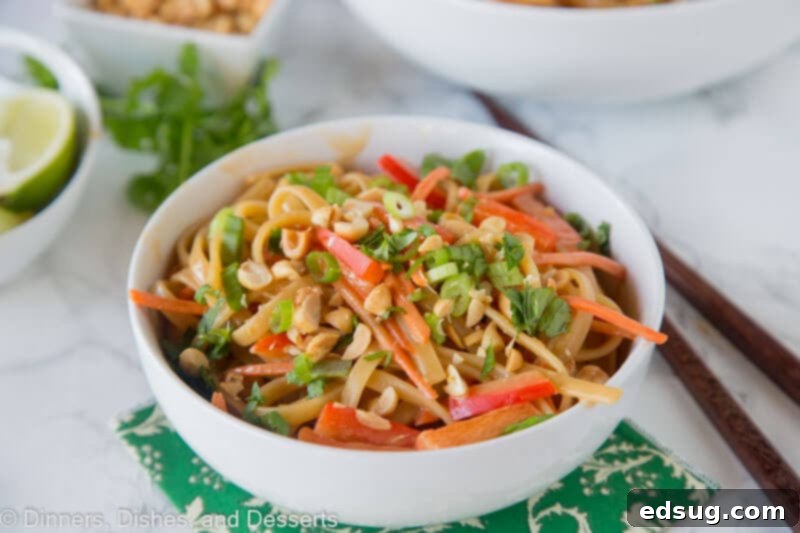
Crafting Your Thai Peanut Noodles: A Simple Step-by-Step Guide
You’ll be amazed at how incredibly simple this dish is to prepare! With just a few straightforward steps, you’ll have a delicious, comforting meal ready in no time. Below, you’ll find a more detailed breakdown, and remember to scroll down for the full, printable recipe card, which also includes fantastic options for different recipe variations.
- Cook Your Noodles: Begin by cooking your chosen noodles according to the package directions. It’s crucial to cook them al dente, as they will continue to absorb some of the sauce. Once cooked, drain them thoroughly but do not rinse, as the starch helps the sauce adhere better. Keep the pot you cooked them in handy – the residual heat will be key!
- Whisk the Sauce: While your noodles are cooking, prepare the star of the show: the creamy peanut sauce. In a liquid measuring cup or a small mixing bowl, whisk together all of your sauce ingredients. Continue whisking until the mixture is completely smooth and all ingredients are well blended. This ensures a consistent and luscious texture for your noodles.
- Combine & Coat: Once the pasta is cooked and drained, return it immediately to the hot pot it was cooked in. This residual heat is important for warming the sauce through. Pour in your perfectly blended peanut sauce, along with your prepped veggies (thinly sliced bell peppers and shredded carrots). Toss everything together thoroughly, ensuring every strand of noodle and every piece of vegetable is beautifully coated in the creamy sauce.
- Garnish & Serve: For the perfect finishing touch, top your warm and comforting noodle bowl with a generous sprinkle of chopped peanuts for crunch and fresh cilantro for a burst of vibrant flavor. Serve immediately and enjoy!
The magic happens when the hot noodles and the residual heat from the pot gently warm the sauce through, creating a wonderfully comforting and cohesive dish. This method ensures your sauce is perfectly integrated, not just clinging to the noodles but truly infusing them with flavor.
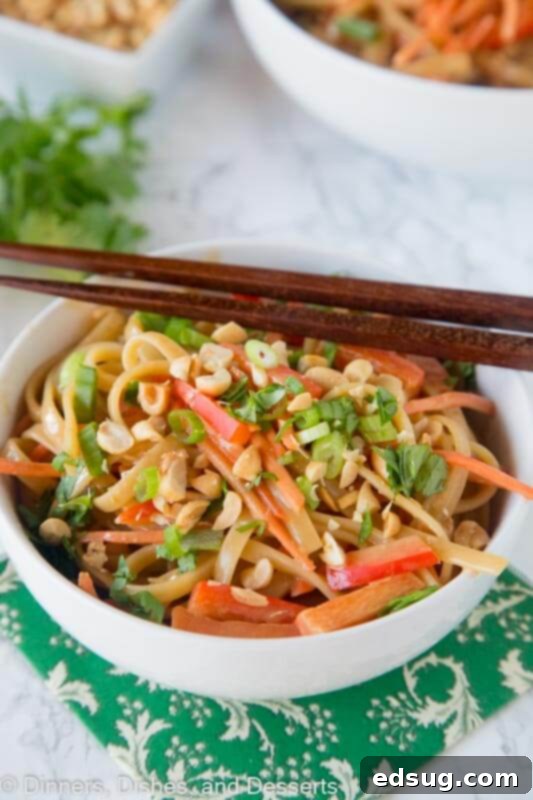
Elevate Your Dish: Creative Recipe Variations
One of the best things about these Thai Peanut Noodles is how incredibly adaptable they are. Whether you’re looking to add more protein, boost the veggie count, or simply customize the flavors, the possibilities are truly endless. Here are some fantastic ideas to make this dish your own:
- Add Protein for a Heartier Meal:
This recipe shines as a quick and easy meat-free option, but it also serves as an excellent base for various proteins. Consider adding:
- Chicken: Sliced chicken breast or thighs, quickly sautéed until golden brown, or even shredded rotisserie chicken for extra speed.
- Shrimp: Cook shrimp in a hot skillet for just a few minutes until pink and opaque. They cook very quickly, making them perfect for a fast meal.
- Pork Tenderloin: Thin strips of pork tenderloin, seared quickly, add a tender, savory element.
- Tofu: For a plant-based protein boost, press extra-firm tofu to remove excess water, cube it, and pan-fry or bake until crispy. This adds a wonderful texture contrast.
- Beef: Thinly sliced flank steak or sirloin, quickly stir-fried, would also be a delicious addition.
Tip: If adding protein, I recommend cooking it in a large skillet first. Once cooked, set it aside, then proceed with the sauce and noodles. Finally, combine everything in the skillet to ensure even coating before serving.
- Boost Your Veggies:
Because the base recipe uses raw vegetables that are simply tossed with the hot noodles, it’s super fresh. However, you can definitely expand your vegetable horizons! Don’t hesitate to incorporate your favorites or whatever you have in the fridge.
- Broccoli florets: Lightly steamed or quickly blanched for vibrant color and tender-crisp texture.
- Zucchini or yellow squash: Thinly sliced or julienned.
- Mushrooms: Sliced and sautéed until tender and golden.
- Snow peas or snap peas: Add them in raw for a crisp bite, or quickly blanch them.
- Bean sprouts: A classic Asian noodle topping, adding freshness and crunch.
- Edamame: Shelled edamame (fresh or frozen, thawed) for added protein and green goodness.
- Bok choy or spinach: Wilted into the hot noodles and sauce.
Tip: If you prefer your vegetables cooked rather than raw, simply sauté them in a large skillet (after your protein, if adding) until they reach your desired tenderness, then add the cooked noodles and sauce to the same pan to combine.
- Customize Your Toppings:
Toppings aren’t just for decoration; they add crucial layers of texture and flavor! While chopped peanuts and fresh cilantro are fantastic, consider these additions:
- Sesame seeds: Toasted sesame seeds for extra nuttiness and visual appeal.
- Green onions: Sliced green onions (scallions) provide a mild, fresh onion flavor and a pop of color.
- Lime wedges: A squeeze of fresh lime juice just before eating brightens all the flavors.
- Chili oil or Sriracha: For those who love extra heat, a drizzle of chili oil or a dollop of Sriracha can take it up a notch.
- Crispy fried shallots or garlic: For an extra layer of savory crunch.
- Adjust the Spice Level:
The original recipe calls for 1/2 teaspoon of crushed red pepper, which provides a mild warmth. If you prefer:
- Milder: Reduce or omit the crushed red pepper.
- Spicier: Increase the crushed red pepper to 1 teaspoon or more, or add a dash of chili garlic sauce or sriracha to the sauce mixture.
Choosing the Best Noodles for Thai Peanut Noodles
One of the beauties of this Thai Peanut Noodles recipe is its incredible flexibility when it comes to the type of noodles you can use. Don’t feel limited to a specific variety; instead, use what you have on hand or what you enjoy most. For this particular recipe, I often use linguine, which works wonderfully, but here’s a broader list of excellent choices:
- Linguine or Spaghetti: These common pasta types are surprisingly versatile in Asian-inspired dishes. Their long, thin strands are perfect for soaking up the creamy peanut sauce.
- Ramen Noodles: Often found in instant noodle packets (discard the seasoning packet), these cook quickly and have a delightful chewiness.
- Udon Noodles: Thick, chewy wheat noodles that offer a satisfying mouthfeel. They hold up well to rich sauces.
- Pad Thai Noodles: Flat, thin rice noodles that are naturally gluten-free and have a slightly chewier texture.
- Lo Mein Noodles: Typically fresh egg noodles, these are springy and absorb sauce beautifully, commonly used in stir-fries.
- Rice Vermicelli: Very thin rice noodles that cook almost instantly and become incredibly silky. Best for a lighter texture.
- Gluten-Free Pasta: If you’re avoiding gluten, opt for gluten-free spaghetti, linguine, or rice noodles. Ensure they are cooked according to package directions as their textures can vary.
Ultimately, the goal is for the noodles to soak up all that delicious sauce and provide a satisfying base. Experiment with different types to find your personal favorite!
Storage and Meal Prep Tips
These Thai Peanut Noodles are fantastic for meal prep and make for even better leftovers! If you’re someone who enjoys cold Asian leftovers straight from the fridge, this dish is absolutely perfect for you. Here’s how to best store and enjoy your noodles:
- Refrigeration: Store any leftover Thai peanut noodles in an airtight container in the refrigerator for up to 3-4 days. The flavors often meld and deepen overnight, making them even more delicious.
- Serving Cold: Many people adore these noodles chilled, as the sauce becomes thicker and richer. It’s a refreshing option for lunch or a light dinner.
- Reheating: If you prefer them warm, you can easily reheat them in the microwave. Start with 1-2 minutes, stir, and continue heating in 30-second intervals until warmed through. If the noodles seem a bit dry or clumped, add a splash of water or vegetable broth while reheating to loosen the sauce and bring back its creamy consistency. You can also reheat gently on the stovetop over low heat, adding a little liquid as needed.
- Freezing: While technically possible, freezing noodle dishes with creamy sauces is generally not recommended. The noodles can become mushy, and the sauce may separate or change texture upon thawing. It’s best enjoyed fresh or from the fridge.
Preparing this dish ahead of time can be a lifesaver for busy weeks. You can prepare the peanut sauce up to 3 days in advance and store it in an airtight container in the fridge. Cook your noodles and chop your vegetables just before you’re ready to assemble, and you’ll have dinner on the table in minutes!
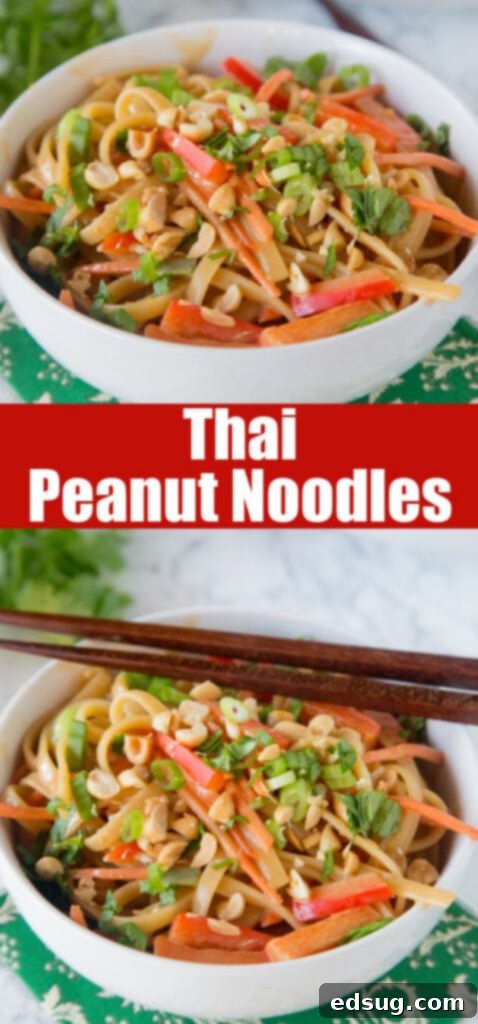
More Easy Asian-Inspired Recipes
If you love the flavors of these Thai Peanut Noodles, you’re in for a treat! We have a wide array of other simple and delicious Asian-inspired recipes that are perfect for quick weeknight dinners or flavorful weekend meals. Explore some of our other popular dishes:
- Cashew Chicken
- Bourbon Chicken
- Pork Stir Fry
- Asian Dumplings
- Curry Chicken
- Kung Pao Chicken
- Asian Chicken Wraps
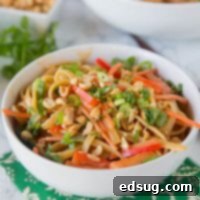
Thai Peanut Noodles
Erin Sellin
5 minutes
10 minutes
15 minutes
4
-5
Pin Recipe
Rate Recipe
Print Recipe
Equipment
-
Pot and Pan Set
-
Measuring Cups
-
Measuring Spoons
Ingredients
-
16 oz pasta, (rice noodles, linguine, spaghetti etc) -
1 cup
shredded carrots
-
1
bell pepper
, thinly sliced
Sauce
-
1/2 cup
creamy peanut butter
-
1/4 cup water -
1/4 cup
soy sauce
-
2 Tablespoons
honey
-
1 Tablespoons
rice vinegar
-
1 Tablespoons
ginger
, grated -
3 cloves
garlic
, finely minced -
1 Tablespoons
sesame oil
-
1/2 teaspoon
crushed red pepper
Toppings
-
Sliced green onions
-
Chopped peanuts -
Cilantro
-
Limes
Instructions
-
Cook pasta according to package directions until al dente. Drain well.
-
In a liquid measuring cup or small bowl, combine all of the ingredients for the sauce (peanut butter, water, soy sauce, honey, rice vinegar, ginger, garlic, sesame oil, and crushed red pepper). Whisk until completely smooth and well-blended.
-
Once pasta is cooked and drained, return it to the hot pot. Pour in the prepared peanut sauce, add the thinly sliced bell peppers and shredded carrots. Mix thoroughly to ensure all ingredients are evenly coated. The residual heat from the noodles and pot will warm the sauce.
-
Serve immediately, topped with sliced green onions, chopped peanuts, fresh cilantro, and a few lime slices on the side for an extra burst of fresh flavor.
Notes
Recipe Adapted from Cooking Classy
Nutrition
Serving:
1
g
|
Calories:
501
kcal
|
Carbohydrates:
72
g
|
Protein:
17
g
|
Fat:
17
g
|
Saturated Fat:
3
g
|
Polyunsaturated Fat:
11
g
|
Sodium:
845
mg
|
Fiber:
6
g
|
Sugar:
12
g
Nutrition information is automatically calculated, so should only be used as an approximation.
Additional Info
Erin Sellin
5 minutes
10 minutes
15 minutes
Dinner Recipes
American, Asian
4
-5
501
Like this recipe? Leave a comment below!
Frequently Asked Questions (FAQs)
- Is this Thai Peanut Noodle recipe vegetarian or vegan?
- Yes, the base recipe is vegetarian as written! To make it fully vegan, simply swap the honey for maple syrup or agave nectar. All other ingredients are plant-based.
- Can I make these noodles gluten-free?
- Absolutely! This recipe is easily adaptable to be gluten-free. Just ensure you use gluten-free pasta (like rice noodles, gluten-free spaghetti, or other GF certified noodles) and substitute regular soy sauce with tamari, which is a gluten-free soy sauce alternative.
- Can I use crunchy peanut butter instead of creamy?
- Yes, you can! Crunchy peanut butter will give your sauce a slightly different texture with small pieces of peanuts throughout, adding extra crunch. It’s a matter of personal preference.
- How can I adjust the consistency of the peanut sauce?
- If your sauce seems too thick, you can thin it out by whisking in a tablespoon of warm water or vegetable broth at a time until it reaches your desired consistency. If it’s too thin, you can try adding a little more peanut butter, or let it sit for a few minutes to thicken slightly, especially after being mixed with warm noodles.
- Can I make this dish ahead of time for meal prep?
- Yes, it’s a great meal prep option! You can prepare the peanut sauce up to 3 days in advance and store it in an airtight container in the refrigerator. The noodles themselves are best cooked just before serving for optimal texture, but leftovers are delicious cold or reheated.
I created a fun group on Facebook, and I would love for you to join us! It’s a place where you can share YOUR favorite recipes, ask questions, and see what’s new at Dinners, Dishes and Desserts (so that you never miss a new recipe)!
Be sure to follow me on Instagram and tag #dinnersdishes so I can see all the wonderful DINNERS, DISHES, AND DESSERTS recipes YOU make!
Be sure to follow me on my social media, so you never miss a post!
Facebook |
Twitter |
Pinterest |
Instagram
